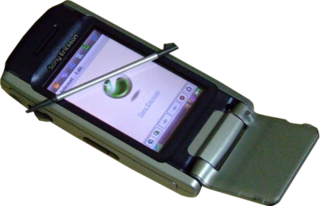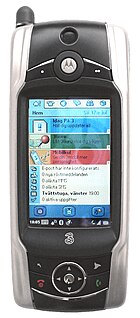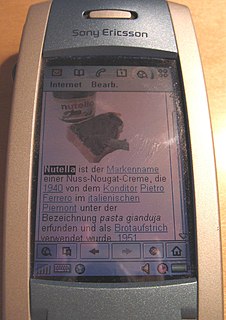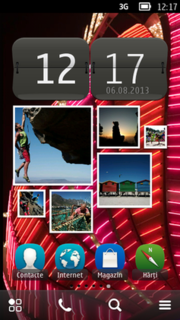Symbian Ltd. was a software development and licensing consortium company, known for the Symbian operating system (OS), for smartphones and some related devices. Its headquarters were in Southwark, London, England, with other offices opened in Cambridge, Sweden, Silicon Valley, Japan, India, China, South Korea, and Australia.

The S60 Platform is a software platform for smartphones that runs on top of the Symbian operating system. It was created by Nokia based on the 'Pearl' user interface from Symbian Ltd. It was introduced at COMDEX in November 2001 and first shipped with the Nokia 7650 smartphone. The platform has since seen 5 updated editions. Series 60 was renamed to S60 in November 2005.
Sony Mobile Communications Inc. was a multinational telecommunications company founded on October 1, 2001, as a joint venture between Sony Group Corporation and Ericsson. It was originally incorporated as Sony Ericsson Mobile Communications, and headquartered in London, England, until Sony acquired Ericsson's share in the venture on February 16, 2012. On April 1, 2021, Sony integrated its electronics businesses including Sony Mobile into one company called Sony Corporation.

UIQ was a software platform based upon Symbian OS, created by UIQ Technology AB. It is a graphical user interface layer that provides additional components to the core operating system, to enable the development of feature-rich mobile phones that are open to expanded capabilities through third-party applications.

The Sony Ericsson P900 is a Symbian OS v7.0 based smartphone from Sony Ericsson.

The Sony Ericsson P910 is a smartphone by Sony Ericsson introduced in 2004 and the successor of the Sony Ericsson P900. The P910 has a full QWERTY keyboard on the back of the flip. The biggest change from the P900 to the P910 is that the P910 supports Memory Stick PRO Duo and the phone's internal memory has been upped from 16 MB to 64 MB. Although Memory Stick PRO Duo comes in larger capacities, the maximum supported by the P910i is 2 GB. It is powered by an ARM9 processor clocked at 156 MHz and runs the Symbian OS with the UIQ graphical user interface. Also, the touchscreen displays 262,144 colours, as opposed to the P900's 65,536 (16-bit). It comes in three versions:

Siemens Mobile was a German mobile phone manufacturer and a division of Siemens AG. Siemens sold Siemens Mobile to the Taiwan-based BenQ in 2005, subsequently becoming BenQ-Siemens and succeeded by Gigaset. The last Siemens-branded mobile phones, the AL21, A31 and AF51, were released in November 2005.

Motorola A925 is a 3G smartphone from Motorola using Symbian OS. Among the most notable features is its built-in A-GPS. The A925 was preceded by the featurewise essentially identical Motorola A920, and was succeeded by the Motorola A1000.

The Sony Ericsson P800 is a smartphone introduced in 2002 based upon UIQ version 2.0 from Sony Ericsson. The P800 is considered the successor of the Ericsson R380, and initial design work was done within Ericsson, but it was produced after Sony & Ericsson merged their mobile phone businesses.

Sony Ericsson P990 is a smartphone and the successor of Sony Ericsson P910. The phone uses the UIQ 3 software platform, which is based upon Symbian OS 9.1. It was introduced on 11 October 2005, but had a long delayed market release only in August 2006.

Sony Ericsson M600 is a 3G smartphone based upon the UIQ 3 platform. It was announced on February 6, 2006 and is the first and only product of the M series of handsets from Sony Ericsson.

UIQ Technology AB was a Swedish company that developed and licensed the UIQ software based on Symbian OS which was used in smartphone offerings from Sony Ericsson, Motorola, BenQ and Arima. They were based in the Soft Center Science & Research Park in Ronneby, Sweden, and at the time of its closure in 2009 was jointly owned by Motorola and Sony Ericsson.
Motorola Rizr is a series of slide mobile phones from Motorola, and is one of the series in the 4LTR line. The first model was released in late 2006. It is a sliding phone, where the numeric keys are hidden beneath the screen of the phone when closed.

The Sony Ericsson P1 is a smartphone and the successor of the P990. It was the last of the Sony Ericsson "P" Smartphone series, introduced in 2002 with the Sony Ericsson P800 and it integrates many of the hardware features of its predecessor the P990 in the form factor of the M600. It was announced on 8 May 2007. There is a Chinese version of P1 called P1c. Compare with P1/ P1i, P1c lacks of 3G, thereby using EDGE which is much slower but more available especially in the US and parts of Europe.
A mobile operating system is an operating system for mobile phones, tablets, smartwatches, 2-in-1 PCs, smart speakers, or other mobile devices. While computers such as typical laptops are 'mobile', the operating systems used on them are generally not considered mobile ones, as they were originally designed for desktop computers that historically did not have or need specific mobile features. This line distinguishing mobile and other forms has become blurred in recent years, this is due to the fact that newer devices have become smaller and more mobile unlike hardware of the past. Key notabilities blurring this line are the introduction of tablet computers and light-weight laptops.

The Sony Ericsson Satio (U1) is a smartphone, announced by Sony Ericsson at the Mobile World Congress in Barcelona, Spain on 15 February 2009 as the Idou. It was released on 7 October 2009 in the UK in 3 colour schemes: Black, Silver and Bordeaux (Red).

Symbian is a discontinued mobile operating system (OS) and computing platform designed for smartphones. Symbian was originally developed as a proprietary software OS for PDAs in 1998 by the Symbian Ltd. consortium. Symbian OS is a descendant of Psion's EPOC, and was released exclusively on ARM processors, although an unreleased x86 port existed. Symbian was used by many major mobile phone brands, like Samsung, Motorola, Sony Ericsson, and above all by Nokia. It was also prevalent in Japan by brands including Fujitsu, Sharp and Mitsubishi. As a pioneer that established the smartphone industry, it was the most popular smartphone OS on a worldwide average until the end of 2010, at a time when smartphones were in limited use, when it was overtaken by iOS and Android. It was notably less popular in North America.
This is a list of devices that run on the Symbian platform mobile operating system, including their proprietary predecessors running on Symbian OS and EPOC.

The Nokia X7-00 is a Symbian^3 smartphone from the Nokia Xseries. It is the first Xseries phone with Nokia's Symbian^3 platform and it shipped with the Anna update. It is also the successor to X6, which was the previous multimedia touchscreen phone, with similar features and specifications in the series. The X7-00 was announced on 12 April 2011, alongside the Nokia E6.

The Nokia 603 is a Symbian smartphone announced on 13 October 2011. It ships with the Symbian Belle OS. Later with the release of Nokia 808 PureView, an update of Belle Feature Pack 2 was released for the phone. Nokia 603 is a low-cost device featuring a 3.5-inch ClearBlack display, 1.0 GHz processor, and NFC.














